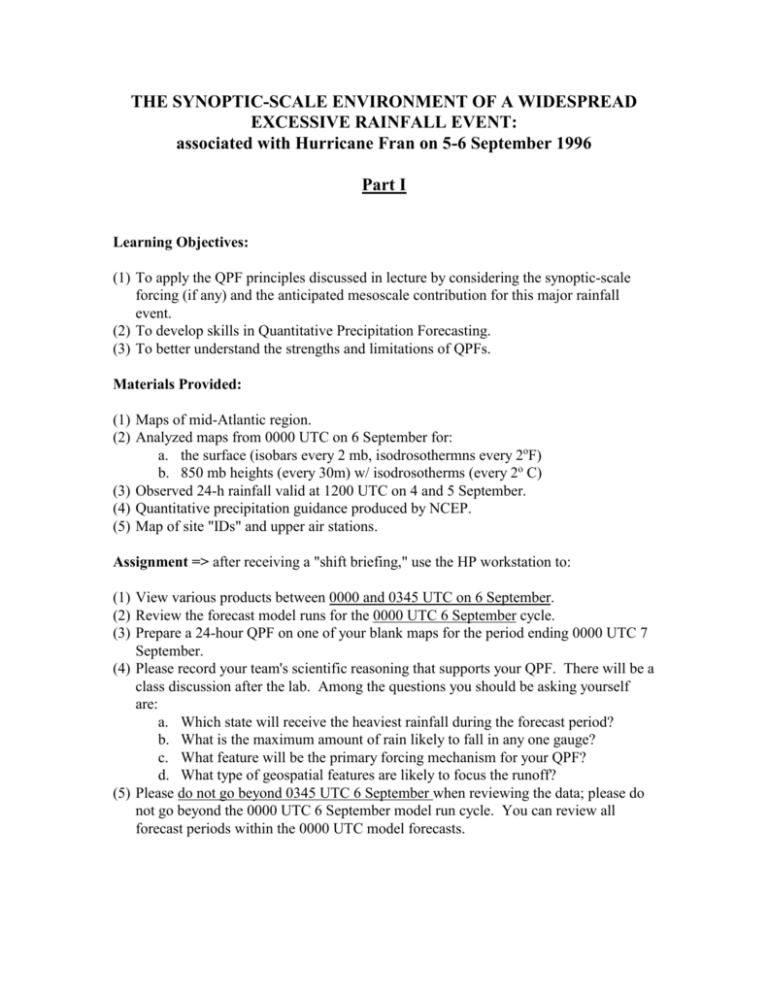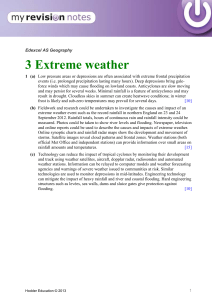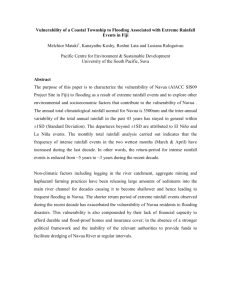the synoptic-scale environment of a widespread excessive
advertisement

THE SYNOPTIC-SCALE ENVIRONMENT OF A WIDESPREAD EXCESSIVE RAINFALL EVENT: associated with Hurricane Fran on 5-6 September 1996 Part I Learning Objectives: (1) To apply the QPF principles discussed in lecture by considering the synoptic-scale forcing (if any) and the anticipated mesoscale contribution for this major rainfall event. (2) To develop skills in Quantitative Precipitation Forecasting. (3) To better understand the strengths and limitations of QPFs. Materials Provided: (1) Maps of mid-Atlantic region. (2) Analyzed maps from 0000 UTC on 6 September for: a. the surface (isobars every 2 mb, isodrosothermns every 2oF) b. 850 mb heights (every 30m) w/ isodrosotherms (every 2o C) (3) Observed 24-h rainfall valid at 1200 UTC on 4 and 5 September. (4) Quantitative precipitation guidance produced by NCEP. (5) Map of site "IDs" and upper air stations. Assignment => after receiving a "shift briefing," use the HP workstation to: (1) View various products between 0000 and 0345 UTC on 6 September. (2) Review the forecast model runs for the 0000 UTC 6 September cycle. (3) Prepare a 24-hour QPF on one of your blank maps for the period ending 0000 UTC 7 September. (4) Please record your team's scientific reasoning that supports your QPF. There will be a class discussion after the lab. Among the questions you should be asking yourself are: a. Which state will receive the heaviest rainfall during the forecast period? b. What is the maximum amount of rain likely to fall in any one gauge? c. What feature will be the primary forcing mechanism for your QPF? d. What type of geospatial features are likely to focus the runoff? (5) Please do not go beyond 0345 UTC 6 September when reviewing the data; please do not go beyond the 0000 UTC 6 September model run cycle. You can review all forecast periods within the 0000 UTC model forecasts. THE MESOSCALE ENVIRONMENT OF AN EXCESSIVE RAINFALL EVENT IN CENTRAL APPALACHIA: associated with Hurricane Fran on 5-6 September 1996 Part II Learning Objectives: (1) To consider the mesoscale contribution to the excessive amounts of convective rainfall during this event. (2) To relate mesoscale features accompanying this event with similar features illustrated during classroom presentations. (3) To learn how this flood event transitioned from a "forecastable" synoptic-scale setup into a short-fused, mesoscale-driven hydrometeorological event. (4) To begin understanding the performance issues of WSR-88D with excessive tropical precipitation. Materials Provided: (1) (2) (3) (4) Map of county area of responsibility (VA,WV,MD). Observed 24-hour rainfall ending 1200 UTC on 6 September. Virginia IFLOWS reports for 12-hr period ending 7am EDT (1100 UTC) 6 Sept. Flash Flood Guidance (1/6/12 hr). Assignment => After receiving an "updated shift briefing" you will review any graphics/images/forecast model runs that were made through 1300 UTC 6 September (including any forecast period from the 0000 UTC 6 September model runs). Then, answer the following: (1) What is the maximum amount of rain that will fall in any one rain gauge for the 12hour period and the 24-hour period ending 0000 UTC 7 September? How does this compare with what you thought in Part I. (2) What meteorological feature or ingredients served as the primary forcing mechanism to determine the location of the heaviest rainfall? Did this change during the course of the event? (3) What hydrologic feature or ingredients were most important for flash flooding? (4) What was the maximum WSR-88D rainfall estimates and how did they vary from radar to radar? (5) Did "warm rain processes" possibly play a role in the precipitation production? *NOTE: The radars from Virginia northward were using a tropical Z-R conversion in the derivation of rainfall. The Raleigh, NC radar was using the default Z-R conversion. A WIDESPREAD EXCESSIVE RAINFALL EVENT IN THE MIDAPPALACHIANS ASSOCIATED WITH LAND-FALLING HURRICANE FRAN, 6 SEPTEMBER 1996. Part III: Summary What Happened: Hurricane Fran made landfall in southeastern North Carolina shortly before 0000 UTC 6 September 1996. In the next 24 hours it moved northward through North Carolina and Virginia, and then continued northward into the eastern Great Lakes region on the 7th. Major main stem river flooding (historic in several cases) and numerous reports of flash flooding were recorded in north-central North Carolina, Virginia, extreme eastern West Virginia, and the Maryland panhandle. All four major river systems in Virginia experienced major flooding. The most important 24-hour period for QPF and short term flash flood forecasts was the period ending 0000 UTC 7 September. The rainfall reports: Numerous rainfall reports of greater than 6 inches, and some over 12 inches occurred from north central North Carolina (in the Raleigh Durham area) to extreme western Maryland. The mountains and valleys of western Virginia and extreme eastern West Virginia received some of the greatest accumulations. Rainfall totals exceeded 20 inches in Page County Virginia, with the 24- and 12-hour periods ending 7pm EDT (2300 UTC) 6 September receiving as much as 15.61 and 13.29 respectively (see included maps of IFLOWS reports). Rainfall data can also be viewed at http://www.nws.noaa.gov/er/lwx/lwxfld2.jpg. Excessive rainfall production: Excessive rainfall in north-central North Carolina was associated with eyewall convection. Urban flash flooding as well flash flooding along Crabtree Creek were particularly noteworthy. The eyewall structure degenerated as the storm moved northward into Virginia. In Virginia and portions of West Virginia and Maryland, the most intense rainfall was associated with the remnants of the feeder bands transporting moisture westward into higher terrain. The main crest of the Appalachians (including the Shenandoah and Allegheny mountains), and the Blue ridge further to the east had a major impact on the distribution of heaviest precipitation. The Shenandoah Valley was particularly hard hit. Page County, Virginia received the greatest amount of road damage from flash flooding. Naked Creek in Rockingham County, Virginia was the site of particluarly severe flash flooding. (Reports and summaries from the appropriate WFOs are attached). Other things to consider: Although this was a land-falling tropical cyclone scenario, some other meteorological features typically associated with flash flooding were in place. A negatively tilted upper level ridge was producing mainly light steering flow along and into the mountains ranges. Impressive low-level inflow air was supplying additional low level moisture as well as enhancing low-level upslope flow. And a deep warm and humid layer worked with the aforementioned ingredients to enhance the precipitation efficiency of the clouds. And how about those radars: As with just about all flood events involving convective rains, the radar proved to be very valuable for excellent spatial and temporal detail. And as with many events there are some questions about the quantitative accuracy (although this appears to be one of the better events). All but the Raleigh Durham radar (KRAX) were coordinated with the Mid-Atlantic RFC and went with the tropical Z-R. Based on the ground reports it appears that the tropical Z-R resulted in derived rainfall amounts that were representative of the processes occurring during this event. However, the Z-R issue was not (and rarely is) the only important consideration. Beam blockage from terrain can be seen in certain areas of the Blacksburg (KFCX) and Sterling (KLWX) radars. In addition, the Sterling radar is apparently suffering from some miscalibration during this period causing it to read cold, a problem that could easily counteract any improvements to Z-R conversions. The Raleigh radar (KRAX) appears to have overestimated rainfall with the tropical Z-R. But beware, strong winds which blew down trees in the Raleigh area certainly had an impact rain gauge catchment. Rain gauge measurements in the Raleigh area were likely at least 20% low. These were all considerations that the forecaster needed to be mindful of when making optimal use of radar guidance.







